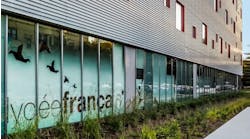The condition of a school's restrooms can set the tone for how students view the facility: Is it safe and healthful? Will they treat it with respect? Or do neglect and unsanitary conditions reflect the apathy and disdain that permeate the building?
The Collaborative for High Performance Schools Best Practices Manual for Maintenance and Operations provide recommendations for maintaining restrooms.
Daily cleaning, the manual states, should include emptying trash; refilling paper towel, toilet paper and soap dispensers; cleaning mirrors and glass surfaces; cleaning toilets and urinals with a non-acid soap remover; disinfecting all surfaces and fixtures; microfiber mopping floors; and wet mopping with a cleaner or disinfectant.
Weekly cleaning, the manual says, generally covers the same steps, but often involve the use of brushes and scrub pads to remove stains and soil, and the use of chemicals in higher concentrations to remove hard-to-remove stains.
"Lime and rust stains are two of the more common stubborn stains that plague toilets," the manual says. "These stains generally cannot be removed using the daily cleaner."
Schools also should consider surface cleaning systems or vapor steam cleaners to clean sinks, toilets and urinals, showers, locker rooms and other tiled surfaces, the manual says.
Dirty mop bucket water from restroom cleaning should not be used for cleaning other areas of the school, the manual recommends. Custodians and other staff should wear appropriate protective equipment — gloves and wet-splash goggles should be available when using cleaning products, especially disinfectants. Schools should avoid using chlorine bleach solutions.
Read the main story, "Washrooms/Locker Rooms," to learn more.
